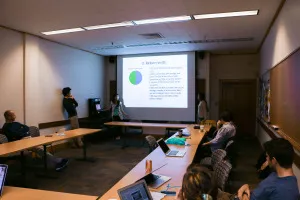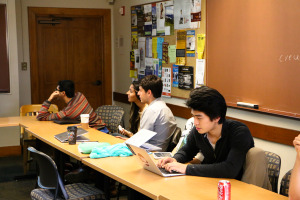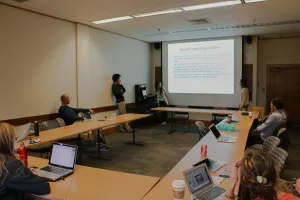
“Have you heard of Tinder?” Professor Sebastian Thrun asks me immediately after I enter the classroom. He’s standing in the front of the room along with another student, Baris Akis, who’s presenting his group’s project: the “Thinkers Accordion,” an app that presents the name of a philosopher or author or sociologist, etc. along with a small blurb of the person’s main ideas and important thoughts. If the user likes it, he/she can swipe down for more detail, but if the user isn’t really interested, he/she can just swipe to the side for another individual – a process based on Tinder, the hit dating app.
Married couple Petra Dierkes-Thrun, from the Comparative Literature department, and Sebastian Thrun, from the CS department, co-teach CS27, Literature and Social Online Learning. Sebastian Thrun co-founded Udacity, so the topic of online learning comes up a lot during conversations between the two. “We just talk about this all the time, especially because I’m involved in the humanities and him in computer science,” said Dierkes-Thrun. “The question is if any of this online learning is even applicable to the humanities.”
This class gives students in the humanities a chance to create projects they otherwise wouldn’t have the technical capability to create. “I have all sorts of ideas to integrate the humanities into the increasingly technological world, but I never actually built anything,” Dierkes-Thrun explains. “So I just thought it would be interesting to make this an interdisciplinary class, especially with the introduction of the CS+X major.”
The class mainly revolves around student projects. “Usually there’s just one syllabus that everyone follows, but in this class, we basically have six different syllabi running at the same time,” said Dierkes-Thrun.
Junior Baris Akis elaborates on his and Sophomore Farhan Kathawala’s project, the Thinker’s Accordion. “The project was inspired by the fact that you need to read a lot and have a lot of background information in order to understand many of these philosophical ideas, and that it’s very hard to discover many ideas because of this barrier,” said Baris. “Right now, people don’t want to spend time reading stuff, even if it’s just a one page article, so we thought we could just have a quote on the screen, and if people like the quote and think it’s a cool idea, they should see expanded information of that person’s ideology.”

There are also more humanities-based projects. “The class is pretty much 50/50 when it comes to techie and fuzzy majors,” said Sophomore Mirae Lee, who is considering the CS+English joint major. She and senior Vilde Opsal, a senior studying CS, are working on a project that is trying “to get people excited about classical literature by using new technology, which in our case, is the internet. We’re basically doing a fanfiction event on “Pride and Prejudice” with an emphasis on collaborative creation than on individual publishing,” said Lee. “It’s a chance to get people excited about classical literature by using new technology.”
“This kind of integrated class is something you’d only be able to find here at Stanford. I feel like we’re pushing new boundaries and entering new terrain, and it’s very exciting to be a part of that,” continued Lee. “It’s also great to be able to receive direct feedback from the professors.” Junior Asik agreed, saying, “One of my favorite parts of the class is the small setting. It’s very personal, and you know all the other people and their projects, so you can see everyone’s development.”
Even with these seemingly large, time-consuming projects, the professors haven’t had any issues with motivation. “A lot of these students wrote in their self-reflections that they just chose this class as an interesting 3 unit course, and that it’s now taking over their lives.” Dierkes-Thrun laughs, before going on to say, “But they all seem to be very engaged in their projects. It’s very cool to be able to make something that is your own design and creation.
“What I really care about is making really good methods to study literature available to a lot of the public and engaging students. I think there can be an amazing synergy when we put two and two together.”
In terms of serving as a model for professors to introduce new interdisciplinary courses, especially in regards to the implementation of the new CS+X joint major, Thrun states, “This class is a very different kind of work. If somebody like me who doesn’t really have much background in the tech field can offer something like this by reaching out to another professor across the aisle, I think there are endless possibilities out there.”

So to answer Sebastian Thrun’s question in the beginning of class: yes, I have heard of Tinder, but no, I am neither a user nor fan of the app. But after seeing how this dating application’s swiping interface has made its way into this specific course on the intersection of literature and technology in a school that’s well known as an engineering powerhouse, I have come to appreciate the significance that a simple app’s interface can have. Harnessing the power of technology and applying it towards the humanities is to explore the unexplored, where there are literally limitless opportunities. As Petra Dierkes-Thrun says, “dreaming big from time to time in the humanities is kind of a really cool thing.”
Contact Jenny Lu at jennylu18 ‘at’ stanford.edu.